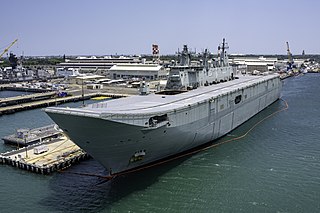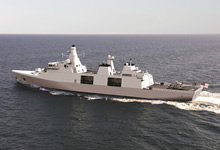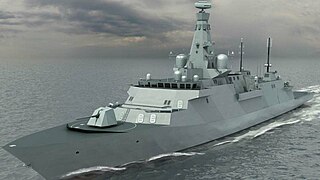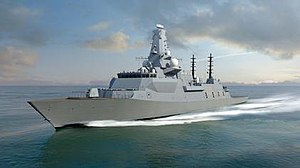
The Type 23 frigate or Duke class is a class of frigates built for the United Kingdom's Royal Navy. The ships are named after British Dukes, thus leading to the class being commonly known as the Duke class. The first Type 23, HMS Norfolk, was commissioned in 1989, and the sixteenth, HMS St Albans was commissioned in June 2002. They form the core of the Royal Navy's destroyer and frigate fleet and serve alongside the Type 45 destroyers. They were designed for anti-submarine warfare, but have been used for a range of uses. Ten Type 23 frigates remain in service with the Royal Navy, with three vessels having been sold to the Chilean Navy, one being retired in 2021, and two being retired in 2023.

The Type 26 frigate, also known as City-class frigate, is a class of frigates being built for the United Kingdom's Royal Navy, with variants also being built for the Australian and Canadian navies. The programme, known as the Global Combat Ship, was launched by the British Ministry of Defence to partially replace the navy's thirteen Type 23 frigates, and for export. Its primary role is to conduct advanced anti-submarine warfare missions while supporting air defence and general purpose operations. The type is the first naval platform shared between Australia, Canada and the United Kingdom since the pre-Second World War Tribal-class destroyer.

The Álvaro de Bazán class, also known as the F100 class, is a class of Aegis combat system-equipped air defence frigates in service with the Spanish Navy. The vessels were built by Spanish shipbuilder Navantia in Ferrol, with the lead ship of the class named for Admiral Álvaro de Bazán.

The FREMM, which stands for "European multi-purpose frigate", is a Franco-Italian family of multi-purpose frigates designed by Naval Group and Fincantieri. In France, this surface combatant is known as the "Aquitaine class", while in Italy it is known as the "Bergamini class". The lead ship of the class, Aquitaine, was commissioned in November 2012 by the French Navy. Italy has ordered six general purpose and four anti-submarine variants. France, on the other hand, has ordered six anti-submarine variants and two air-defense ones.

The Hobart class is a ship class of three air warfare destroyers (AWDs) built for the Royal Australian Navy (RAN). Planning for ships to replace the Adelaide-class frigates and restore the capability last exhibited by the Perth-class destroyers began by 2000, initially under acquisition project SEA 1400, which was re-designated SEA 4000. Although the designation "Air Warfare Destroyer" is used to describe ships dedicated to the defence of a naval force from aircraft and missile attack, the destroyers are expected to also operate in anti-surface, anti-submarine, and naval gunfire support roles.

Chungmugong Yi Sun-sin class destroyers are multipurpose destroyers of the Republic of Korea Navy. The lead ship of this class, ROKS Chungmugong Yi Sunsin, was launched in May 2002 and commissioned in December 2003. Chungmugong Yi Sun-sin-class destroyers were the second class of ships to be produced in the Republic of Korea Navy's destroyer mass-production program named Korean Destroyer eXperimental, which paved the way for the navy to become a blue-water navy. Six ships were launched by Hyundai Heavy Industries and Daewoo Shipbuilding & Marine Engineering in four years.
The Royal Australian Navy, although a significant force in the Asia-Pacific region, is nonetheless classed as a medium-sized navy. Its fleet is based around two main types of surface combatant, with limited global deployment and air power capability. However, in 2009, a white paper, Defending Australia in the Asia Pacific Century: Force 2030, was produced by the Australian government which set out a programme of defence spending that will see significant improvements to the RAN's fleet and capabilities.

The Canberra class is a ship class of two landing helicopter dock (LHD) ships built for the Royal Australian Navy (RAN). Planning to upgrade the navy's amphibious fleet began in 2000, based on Australian experiences leading the International Force for East Timor peacekeeping operation. With a new climate for growing Australian Navy spending, a desire existed for forward defence capability for landing and supporting troops on Asian territory, that had never existed in Australian history, even with the old Majestic-class light fleet carriers, HMAS Melbourne and HMAS Sydney in the 1970s. In 2004, French company Direction des Constructions Navales (DCN) and Spanish company Navantia were invited to tender proposals, with DCN offering the Mistral-class amphibious assault ship and Navantia proposing the "Buque de Proyección Estratégica" design. The Spanish design was selected in 2007, with Navantia responsible for construction of the ships from the keel to the flight deck, and BAE Systems Australia handling the fabrication of the combat and communications systems. Finally, Siemens (Germany) supplied and fitted the azimuth thrusters.

ASC Pty Ltd, formerly the Australian Submarine Corporation, is an Australian government business enterprise involved with Australian naval shipbuilding, headquartered in Osborne, South Australia. It is notable for the construction and maintenance of the Collins-class submarine fleet operated by the Royal Australian Navy (RAN) and the construction of three Hobart-class destroyers for the RAN with the first delivered in mid-2017.

The Canadian Surface Combatant, formerly the Single Class Surface Combatant Project is the procurement project that will replace the Iroquois and Halifax-class warships with up to 15 new ships beginning in the mid to late 2020s as part of the National Shipbuilding Procurement Strategy.
BAE Systems Australia, a subsidiary of BAE Systems plc, is one of the largest defence contractors in Australia. It was formed by the merger of British Aerospace Australia and GEC-Marconi Systems and expanded by the acquisitions of Armor Holdings in 2007 and Tenix Defence in June 2008.

HMAS Hobart, named after the city of Hobart, Tasmania, is the lead ship of the Hobart-class air warfare destroyers used by the Royal Australian Navy (RAN). The ship, based on the Álvaro de Bazán-class frigate designed by Navantia, was built at ASC's shipyard in Osborne, South Australia from modules fabricated by ASC, BAE Systems Australia in Victoria, and Forgacs Group in New South Wales. Hobart was ordered in 2007, but errors and delays in construction caused extensive schedule slippage. Despite commissioning initially planned for December 2014, the ship was not laid down until September 2012, and launched in May 2015. The Department of Defence accepted delivery of HMAS Hobart on 16 June 2017. The ship was commissioned on 23 September 2017.

The Type 31 frigate, also known as the Inspiration class, and formerly known as the Type 31e frigate or General Purpose Frigate (GPF), is a class of five frigates being built for the United Kingdom's Royal Navy, with variants also being built for the Indonesian and Polish navies. The Type 31 is intended to enter service in the 2020s alongside the eight submarine-hunting Type 26 frigate and will replace the five general-purpose Type 23 frigates. The Type 31 is part of the British government's "National Shipbuilding Strategy".
ASC Shipbuilding, formerly the shipbuilding division of ASC Pty Ltd, is a subsidiary of BAE Systems Australia and will remain a subsidiary for the duration of the contract to build the Hunter class frigates. It was structurally separated from ASC Pty Ltd in December 2018 and became a subsidiary of BAE Systems Australia. In 2021 it was renamed as BAE Systems Maritime Australia.

HMAS Sydney, named after the city of Sydney, New South Wales, is the third and final ship of the Hobart class air warfare destroyers used by the Royal Australian Navy (RAN).

HMAS Hunter(FFG) is the lead ship of the Hunter-class frigate of the Royal Australian Navy.

HMAS Flinders(FFG) is the second ship of the Hunter-class frigate of the Royal Australian Navy.

HMAS Tasman(FFG) is the third ship of the Hunter-class frigate of the Royal Australian Navy.
The Type 83 destroyer is a proposed class of guided-missile destroyers which is planned to enter service with the United Kingdom's Royal Navy in the mid-to-late 2030s. It is being developed as a direct replacement for the current flotilla of six Type 45 destroyers.














